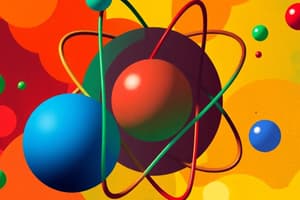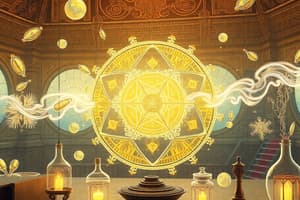Podcast
Questions and Answers
What concept did Dalton's atomic theory formalize about atoms in terms of their properties?
What concept did Dalton's atomic theory formalize about atoms in terms of their properties?
- Atoms of different elements have the same properties.
- Atoms are created and destroyed in chemical reactions.
- Atoms of the same element are identical in mass and properties. (correct)
- Atoms are divisible into smaller particles.
Which subatomic particle was discovered by JJ Thomson?
Which subatomic particle was discovered by JJ Thomson?
- Electron (correct)
- Proton
- Nucleus
- Neutron
What does the atomic number (Z) of an atom represent?
What does the atomic number (Z) of an atom represent?
- The number of electrons in a neutral atom.
- The total number of protons and neutrons.
- The number of protons in an atom. (correct)
- The average atomic mass of an element.
Which statement correctly defines isotopes?
Which statement correctly defines isotopes?
What is the significance of the atomic mass being often a non-whole number?
What is the significance of the atomic mass being often a non-whole number?
In modern atomic theory, how are electrons arranged within an atom?
In modern atomic theory, how are electrons arranged within an atom?
What are orbitals best described as in terms of electron location?
What are orbitals best described as in terms of electron location?
How did Ernest Rutherford contribute to atomic theory?
How did Ernest Rutherford contribute to atomic theory?
Which of the following correctly describes the role of electrons in an atom?
Which of the following correctly describes the role of electrons in an atom?
Why was Dalton's atomic theory challenged in later discoveries?
Why was Dalton's atomic theory challenged in later discoveries?
Flashcards
Atom
Atom
The smallest unit of an element that retains the chemical properties of that element.
Dalton's Atomic Theory
Dalton's Atomic Theory
A theory that states that all matter is composed of tiny, indivisible particles called atoms.
Electron
Electron
Negatively charged particles found orbiting the nucleus of an atom.
Proton
Proton
Signup and view all the flashcards
Neutron
Neutron
Signup and view all the flashcards
Atomic Nucleus
Atomic Nucleus
Signup and view all the flashcards
Atomic Number (Z)
Atomic Number (Z)
Signup and view all the flashcards
Mass Number (A)
Mass Number (A)
Signup and view all the flashcards
Isotopes
Isotopes
Signup and view all the flashcards
Atomic Mass
Atomic Mass
Signup and view all the flashcards
Study Notes
Historical Development of Atomic Theory
- Ancient Greeks (e.g., Democritus) proposed the idea of indivisible particles (atoms).
- Dalton's atomic theory (early 19th century) formalized the concept, proposing:
- Elements are composed of tiny indivisible particles called atoms.
- Atoms of the same element are identical in mass and properties.
- Atoms of different elements have different masses and properties.
- Atoms combine in simple whole-number ratios to form compounds.
- Atoms are neither created nor destroyed in chemical reactions, only rearranged.
- Further discoveries challenged Dalton's postulates, leading to the discovery of subatomic particles.
Subatomic Particles
- Electrons: Negatively charged particles, much smaller than protons and neutrons, discovered by JJ Thomson in the late 19th century through cathode ray experiments.
- Protons: Positively charged particles found in the atomic nucleus, discovered by Ernest Rutherford in the Gold Foil experiment.
- Neutrons: Neutral particles found in the atomic nucleus, discovered by James Chadwick in the 1930s.
Atomic Structure
- The atom is mostly empty space.
- The nucleus, located at the center, contains protons and neutrons.
- Electrons orbit the nucleus in areas described by orbitals, which are regions of probability, not precisely defined orbits.
- Atomic number (Z) represents the number of protons in an atom, dictating the element. Atoms of the same element always have the same number of protons.
- Mass number (A) represents the total number of protons and neutrons in an atom. For a neutral atom, the number of electrons equals the number of protons.
Isotopes
- Atoms of the same element that have different numbers of neutrons, thus having different mass numbers.
- Example: Carbon-12 and Carbon-14
Atomic Mass
- The weighted average mass of all naturally occurring isotopes of an element, taking into account their relative abundance.
- Explains why atomic mass values are often not whole numbers.
Modern Atomic Theory
- Quantum mechanics provides a more comprehensive description of atomic structure and the behavior of electrons.
- Electrons exist in quantized energy levels within orbitals.
- Electrons transition between energy levels by absorbing or releasing specific amounts of energy.
- The arrangement of electrons in an atom (electron configuration) dictates its chemical properties.
Atomic Models
- Early models were simplistic: Thomson's "plum pudding" model and Rutherford's model.
- Modern models incorporate quantum mechanical principles and are more sophisticated, explaining atomic behavior and properties more accurately.
Studying That Suits You
Use AI to generate personalized quizzes and flashcards to suit your learning preferences.




